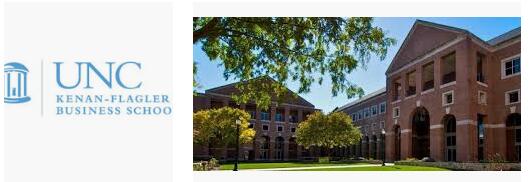Search top business school MBA programs in the state of North Carolina. Find latest rankings of MBA schools national wide and state wide. For detailed admissions statistics and graduate employment rate, check the following table for each top-ranked business college within North Carolina, with acceptance rate, average GPA and GMAT scores, as well as well tuition and starting salary information of all best MBA universities in North Carolina.
North Carolina is home to some of the nation’s top business schools, offering students a variety of degree programs and courses. The Kenan-Flagler Business School at the University of North Carolina at Chapel Hill is one of the state’s top business schools, with an MBA program that is consistently ranked among the best in the world. The program emphasizes experiential learning opportunities, giving students real-world insight into how businesses operate. Specializations such as marketing, finance, operations and strategy are all part of the curriculum at Kenan-Flagler.
The Wake Forest University School of Business is another top business school in North Carolina with an MBA program ranked among the top 50 nationally by U.S. News & World Report. The program focuses on providing students with the skills they need to succeed in today’s dynamic business environment including problem-solving, communication and collaboration skills, and leadership capabilities. Unique aspects of Wake Forest’s program include its focus on sustainability, ethics and social responsibility as well as its emphasis on global understanding to ensure graduates are equipped to compete in an increasingly globalized economy. Courses such as strategic entrepreneurship, data analytics, international finance, and corporate social responsibility are all part of the curriculum at Wake Forest‘s College of Business Administration. In addition to its MBA program, Wake Forest also offers undergraduate degrees in accounting and finance as well as minors in entrepreneurship and management information systems.

| National Ranking | Best Business MBA Programs |
| 12 | Duke University (Fuqua) (Durham, NC) Acceptance rate: 26.5% Average GMAT score: 689 Average undergraduate GPA: 3.44 Tuition: Full-time: $50,300 per year Enrollment (full-time): 888 Average starting salary and bonus: $128,666 Full-time graduates employed at graduation: 78.4%  |
| 20 | University of North Carolina–Chapel Hill (Kenan-Flagler) (Chapel Hill, NC) Acceptance rate: 37.7% Average GMAT score: 689 Average undergraduate GPA: 3.31 Tuition: In-state, full-time: $23,339 per year; Out-of-state, full-time: $47,221 per year Enrollment (full-time): 575 Average starting salary and bonus: $101,904 Full-time graduates employed at graduation: 74.1%  |
| 47 | Wake Forest University (Babcock) (Winston-Salem, NC) Acceptance rate: 41.2% Average GMAT score: 651 Average undergraduate GPA: 3.20 Tuition: Full-time: $38,988 per year Enrollment (full-time): 135 Average starting salary and bonus: $91,504 Full-time graduates employed at graduation: 71.4%  |
| 78 | North Carolina State University (Jenkins) (Raleigh, NC) Acceptance rate: 55.8% Average GMAT score: 592 Average undergraduate GPA: 3.40 Tuition: In-state, full-time: $14,883 per year; Out-of-state, full-time: $27,416 per year Enrollment (full-time): 96 Average starting salary and bonus: $75,309 Full-time graduates employed at graduation: 61.5%  |
| 128 | University of North Carolina–Greensboro (Bryan) (Greensboro, NC) Acceptance rate: 90.9% Average GMAT score: 526 Average undergraduate GPA: 3.23 Tuition: In-state, full-time: $8,670 per year; Out-of-state, full-time: $20,896 per year Enrollment (full-time): 60 Average starting salary and bonus: $48,692 Full-time graduates employed at graduation: 85.7%  |
| 129 | University of North Carolina–Wilmington (Cameron) (Wilmington, NC) Acceptance rate: 73.3% Average GMAT score: 540 Average undergraduate GPA: 3.25 Tuition: In-state, full-time: $17,300 per year; Out-of-state, full-time: $17,300 per year Enrollment (full-time): 30 Average starting salary and bonus: $53,750 Full-time graduates employed at graduation: 0.0%  |
North Carolina is a state located in the southeastern region of the United States and is the 28th largest state in terms of size, with an area of 53,819 square miles. The capital city of North Carolina is Raleigh and the largest city is Charlotte. North Carolina has a population of 10.5 million people and ranks 9th in population size among all US states. It has a diverse landscape, with mountains like the Blue Ridge Mountains in the western part and beaches like Outer Banks in the eastern part. The state’s economy relies heavily on agriculture, textiles, finance, biotechnology, manufacturing, and energy production. North Carolina is also known for its many universities and research centers; its Research Triangle Park houses many technology-based companies making it one of the most important economic hubs in the United States.
Agriculture plays an important role in North Carolina‘s economy; it produces products such as tobacco, poultry, soybeans, cotton, sweet potatoes and hogs. Manufacturing also plays a big role; many companies are based here due to its business-friendly regulations.
North Carolina is known for its mild climate; most areas receive around 45 inches of rain per year on average. The state experiences temperatures ranging from below freezing during winter to over 90 degrees Fahrenheit during summer months.
History of the State of North Carolina
Several battles took place in North Carolina during the Civil War, the most famous of which are the attacks on Fort Fisher and the Battle of Bentonville. Wilmington, which was called the “Gibraltar of the South”, by the end of the war remained the last port available to the Confederacy on the Atlantic coast. It was through him that the southerners could sell tobacco and cotton to the British colonies and buy much-needed ammunition and equipment for them. To protect Wilmington, Fort Fisher was built back in 1861, equipped with batteries of coastal artillery. In December 1864, the northerners made the first attempt to capture the fort, which ended in failure. On January 12, 1865, fifty-six ships of the Union fleet approached the fort, after a two and a half day bombardment, about eight thousand soldiers were landed, six hours later captured the fortifications of the southerners. The Second Battle of Fort Fisher is considered the largest amphibious operation conducted prior to World War II.
The Battle of Bentonville lasted three days, from March 19 to March 21, 1865. It was one of the last battles of the war, during which the troops of the northerners under the command of General Sherman defeated the Confederates. The site of the Battle of Bentonville was designated a National Historic Landmark in the United States in 1996.
In 1868, following the ratification of a new state constitution outlawing slavery, North Carolina was re-admitted to the United States of America. As with other southern states, the reconstruction period for the “Tar Heels State” was very difficult. Before the war, the economy of North Carolina was largely based on plantations that used slave labor, now it was necessary to create new forms of agriculture. In the last decades of the 19th century, industry developed rapidly in the Piedmont area, primarily textile manufacturing, furniture making, and tobacco processing.
Despite the abolition of slavery, the situation of black citizens of North Carolina remained very difficult. Racist sentiment prevailed among most state legislators and many ordinary citizens. At the same time, in the seventies and eighties of the “couple century”, many elective posts (especially in local government bodies) were occupied by African Americans; in 1992). At the same time, laws were passed in the state that complicate participation in elections for African Americans (as, indeed, for the poor with white skin).
The practice of intimidation and violence against former slaves was widespread. In North Carolina, the Red Shirts, who were called the “military wing of the Democratic Party,” felt at ease. Unlike the Ku Klux Klan, the Red Shirts acted openly, often exerting significant influence on election results. In 1898, in Wilmington, white racists seized and burned the office of a pro-black city newspaper, forcing the mayor and city council to resign. Throughout the city, the “Red Shirts” attacked African Americans, several dozen people died, hundreds of people fled. The Wilmington uprising is the only violent overthrow of a municipal government in US history.
In 1900, the brothers Wilbur and Orville Wright selected the coast near Kitty Hawk, North Carolina, for their flying machine experiments. It was here that on December 17, 1903, the Wright brothers for the first time in the world managed to fly on an apparatus heavier than air with an engine.
